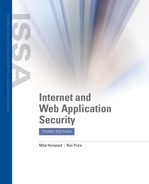CHAPTER 6 ASSESSMENT
-
One way to verify if a system is attacked by a brute-force attack is to periodically check the log files.
- True
- False
-
Content spoofing tactics often include which of the following?
- Spam email links
- Forum links
- Chatroom links
- A and C
- All of these are correct
-
XSS attacks are the same as CSRF attacks.
- True
- False
-
Which of the following attacks involve the use of CR and LF characters? (Select two.)
- HTTP request smuggling
- HTTP response smuggling
- HTTP request splitting
- HTTP response splitting
-
A common path traversal attack uses which syntax sequence to attempt to locate restricted areas on a server?
- ../
- *.*/
- CR
- LF
-
During a session fixation attack, which of the following is not a way an attacker obtains a valid session identifier?
- Prediction
- Capture
- Fixation
- Spoofing
-
Which of the following is not an actual XML-related attack?
- XML attribute blowup
- XML internal entities
- XML entity expression
- XML injection
-
Which of the following are website weaknesses discussed in this chapter?
- OS commanding
- Improper file system permissions
- Insufficient authentication
- Fingerprinting
- All of these are correct
-
Applications hardening is the process of securing applications in use on a network.
- True
- False
-
To avoid improper input handling, which approaches can you use when handling user input? (Select three.)
- Stripping
- Sanitization
- Rejecting known bad input
- Accepting only known good input
